
15 Famous Filipino Games
Get ready for a trip down memory lane! Today, we’re delving into the world of famous Filipino games, where childhood friendships were forged and rivalries sparked.
From the rhythmic clack of sungka seeds to the strategic finesse of patintero, these games were the OGs of our youth. So, tighten those imaginary sweatbands and let’s enjoy the simplicity, laughter, and the thrill of living to play another round.
1. Luksong-Tinik
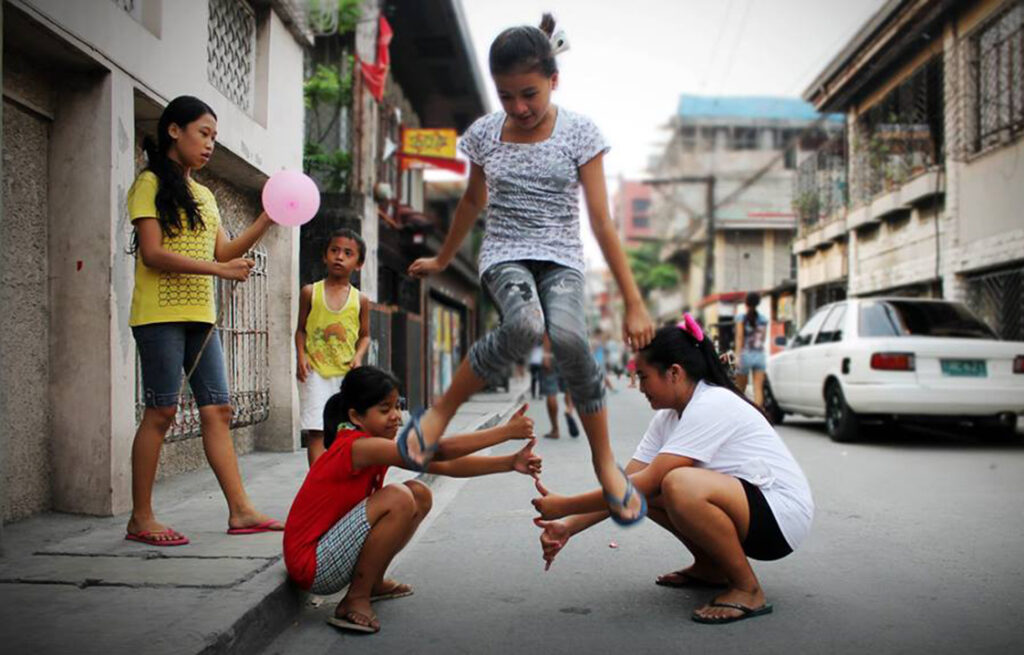
Place of Origin: Cabanatuan, Nueva Ecija
Number of Players: Playable indoors or outdoors and suitable for four to eight participants.
Luksong-Tinik, which literally translates to “jump over the thorns,” was popular from the ’80s to the early 2000s. It is played by two teams, led by a designated “nanay” and accompanied by the energetic “anak.”
The “nanay,” often chosen for their impressive jumping skills, leads their team with enthusiasm. Typically played by girls aged seven to 12 years old, the participants then engage in spirited jumps over outstretched hands.
How to Play This Game:
One team acts as the base with two players sitting and right feet touching, creating a thorn-like barrier. The opposing team jumps over these feet while the non-jumping team raises hands, creating ascending levels of difficulty..
Successful jumps allow participants to reclaim their jumping status, while any contact with the base signals a fault. If a child touches the base, the mother must take their place, adding an extra layer of fun and strategy to the game.
Pro tip:
- Get creative with your “thorns” by arranging hands and feet strategically. Experiment with different formations to keep the game interesting.
2. Tumbang Preso
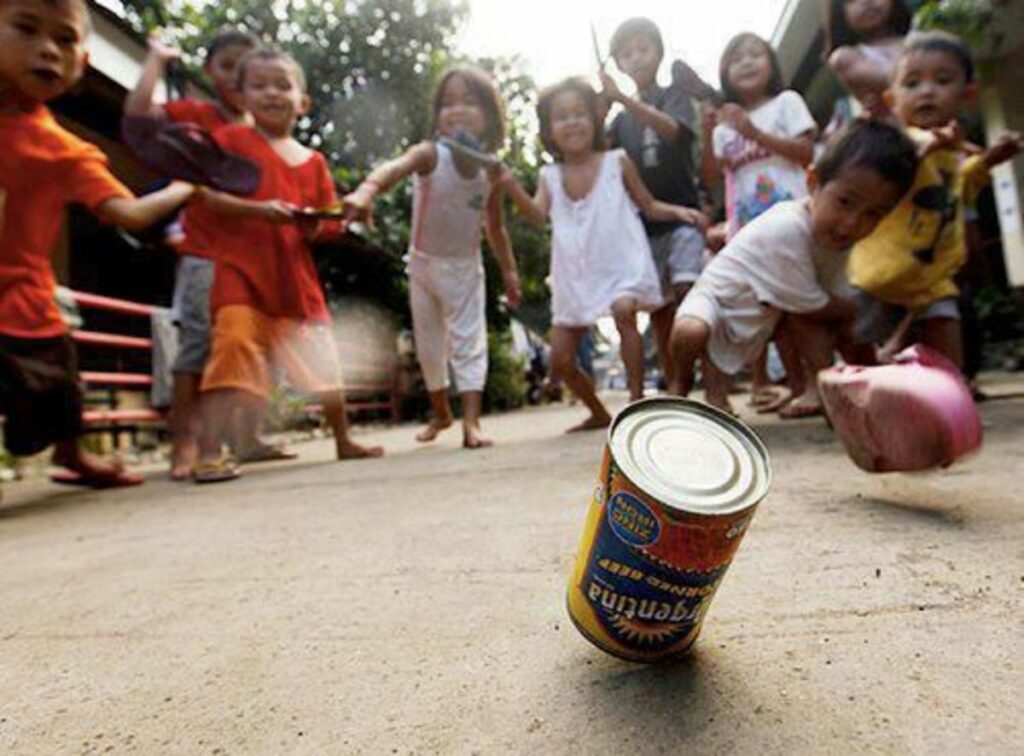
Number of Players: Three or more
What You Need for This Game: Get hold of an empty soda can or any tin can. Each player needs a slipper for striking the can. Locate an open area, space, or field, ensuring it’s obstacle-free.
When it comes to classic Filipino games, Tumbang Preso takes the spotlight in Larong Pinoy. In this game, players embarked on the quest for the sturdiest slipper, with Rambo slippers often claiming victory.
Commonly referred to as tumba lata or bato lata, this game resonates with nostalgic echoes of our childhood. Whether played in backyards, parks, or quiet streets, Tumbang Preso remains a cherished part of Filipino culture, offering timeless fun and laughter.
How to Play This Game:
Form a group of three or more players for maximum enjoyment. A chosen “bantay or taya” guards the tin can, within a circled area, while players aim to knock it down using slippers from six to eight meters away at their homebase.
The bantay catches and tags players, excluding those at the homebase or those who didn’t attempt to knock down the tin can. As players try to hit the tin can, they must avoid the bantay’s circle, and if a slipper lands inside, the bantay can catch that player.
If the tin can is struck and toppled, the bantay must recover and place it to its original position. If a player gets caught while retrieving their slippers, they turn into the new bantay.
Pro tip:
- When knocking down the tin can, position yourself so that even if you miss, the slipper doesn’t end up inside the bantay’s circle. It’s all about calculated risks.
3. Patintero
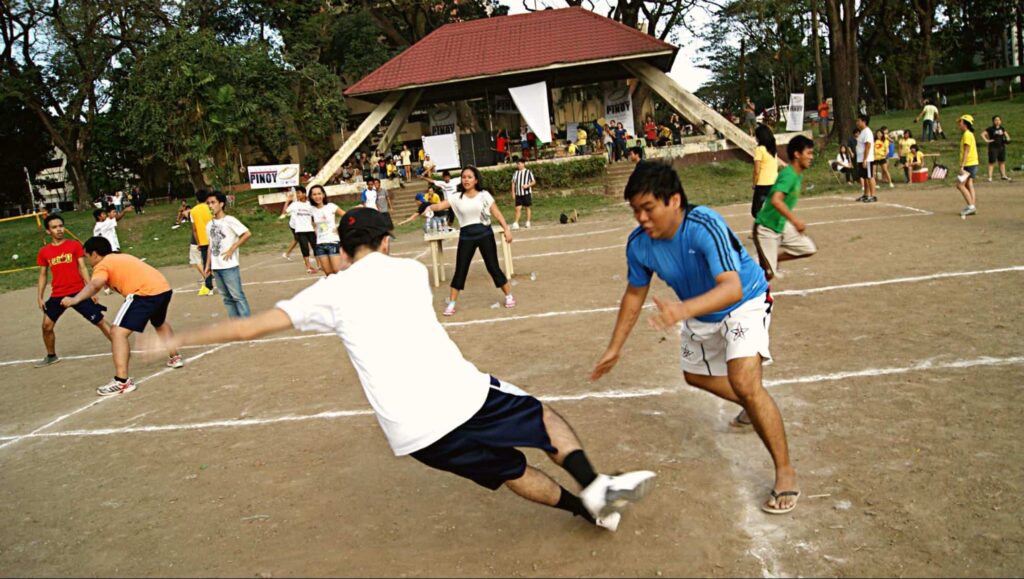
Number of Players: Two teams are required, consisting of approximately two to six players each.
Patintero, also known as “harangang-taga” or “tubigan,” is a classic Filipino game that brings the thrill of outdoor play to a whole new level. It’s not just a test of speed and agility but a fun strategy game that hones hand-eye coordination.
How to Play This Game:
This game requires a rectangular playing area divided into four or six equal sections, with one team guarding these sections while the other attempts to cross without being tagged. A line across the center marks the boundary between the teams.
The team defending the sections, called “it,” aims to tag opponents as they dash across the field. The opposing team, tasked with crossing without getting tagged, utilizes swift movements and teamwork to outmaneuver their opponents.
When a player is tagged, they exit the game, while crossing the big rectangle without being touched earns a point. The game ends for a team when all players are tagged. Teams switch sides, with the other team becoming guards and vice versa.
Pro tip:
- While teammates make a run for it, consider being the distraction. Draw attention to yourself to give them a clear path.
4. Taguan

Number of Players: At least 5 players
“Taguan,” the Filipino version of hide and seek, adds an extra layer of excitement when played at night. The thrill intensifies as darkness becomes both a challenge and advantage for seekers and hiders alike.
With ample hiding spots and the cover of night, players must rely on their wits to outsmart each other. The game’s popularity lies in its blend of suspense and strategy, making it a favorite among Filipino children, especially during the evening hours.
How to Play This Game:
Players kick off the excitement by engaging in an “Umpyang,” a whimsical hand-flipping ritual to determine the first seeker. The game centers on a base, where seekers confirm their discovery and hiders aim to reach before being tagged.
Quick thinking and strategic hiding are essential, as players have a mere 10-15 seconds to secure a hiding spot away from the base. As the seeker counts with eyes closed, a lively counting song adds a musical touch to the suspenseful atmosphere.
“Tagu-taguan maliwanag ang buwan
wala sa likod wala sa harap
makabilang akong sampo
nakatago na kayo 1,2,3,4,5,6,7,8,9,10
walang patawad.”
However, players must be crafty in their hiding spots, as certain locations near the base are off-limits. When finding the hiders, seekers are not allowed to use lighting objects, heightening the excitement of the game.
Pro tip:
- Develop subtle signals with other hiders to communicate without words. A quick hand gesture or shared glance can convey important information, helping the group stay one step ahead of the seeker.
5. Piko

Number of Players: It’s a group game and can be played with two or more players.
What You Need for This Game:
- Marker – typically a chalk, charcoal, or any suitable item for drawing lines on the ground.
- “Pamato” – typically a stone or a fragment of a broken pot.
“Piko,” or the Filipino version of “Hopscotch,” is one of the well-loved Filipino street games, often enjoyed by girls during their elementary school days or in casual street settings after school.
The objective of this game is straightforward: players aim to toss the pamato into each of the numbered squares drawn on the ground. The challenge comes in maintaining balance and agility while hopping through the designated squares.
How to Play This Game:
A flat surface is marked with nine boxes or squares. Players begin by throwing a stone onto the marked area, aiming for number five. The one with the stone closest to five goes first, while the farthest becomes the last player.
The initial player throws the stone at the first box, then skillfully leaps across the area without touching the first box. On the return journey, the player must retrieve the stone without stepping on the first box. Subsequent players simply follow the first player.
The first player progresses to the second box, repeating the process without stepping on it. If a player steps on a line, they pause, allowing the next player a turn, and they must wait until their next opportunity to retry. The first to reach the last box wins.
Pro tip:
- Pay attention to where the Piko lands. Strategically place it closer to your next target square for a swift transition to the next level.
6. Langit-Lupa

Number of Players: Three or more
“Langit-Lupa,” derives its name from the melding of ‘Langit,’ meaning ‘Heaven,’ and ‘Lupa,’ signifying the ‘Earth or ground level.’
This engaging game is beloved for its simplicity, blending strategy with the thrill of evasion as players aim to avoid becoming ‘it’ by skillfully navigating between heavenly heights and the earthly ground.
How to Play This Game:
Players will determine the first ‘it,’ by engaging in a lively ‘jack en poy’ or the classic Filipino version of rock-paper-scissors. Alternatively, they can opt for the strategic ‘ompyang’ process, aiming to be the last player standing.
After finding out who will be the ‘it’, the chase begins. However, there’s a twist—players are safe from tagging if they manage to mount any clamber above ground level or called “Langit.”
The ground-level contenders or those in “Lupa” must sprint and strategize to avoid the ‘it’s’ swift tags, and if caught, they trade places, keeping the game dynamic and everyone on their toes.
Pro tip:
- Practice nimble dodges and sudden direction changes. Being unpredictable in your movements makes it challenging for the ‘it’ to catch you.
7. Sungka
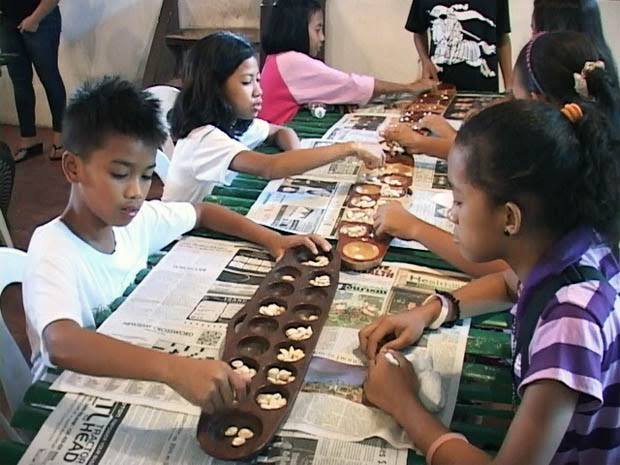
Number of Players: Two
What You Need for This Game:
- 49 pieces of shells or small stones
- Sungkaan or boat-shaped solid wooden board
Sungka is a timeless Filipino game often cherished during family gatherings. Players strategically drop shells or stones into the hollows of a boat-shaped board, known as Sungkaan, aiming to outsmart their opponents and gather more seeds.
Beyond the fun, Sungka serves as a playful exercise for mathematical and analytical thinking, making it a favorite pastime that blends entertainment with mental agility.
How to Play This Game:
The game begins with each hole brimming with seven shells, leaving the homes empty. Two players commence by scooping shells from one of the holes in their respective rows, moving counterclockwise.
An intriguing twist comes with special rules: landing the last piece in one’s home earns an extra turn, capturing shells adjacent to the final landing spot can tip the game, and an empty side leads to an automatic loss of turn.
The game concludes when no shells remain, and the player with the most accumulated shells emerges victorious.
Pro tip:
- Whenever possible, aim to capture shells by landing the last piece in an empty hole on your side. This not only boosts your count but limits your opponent’s options.
8. Sipa
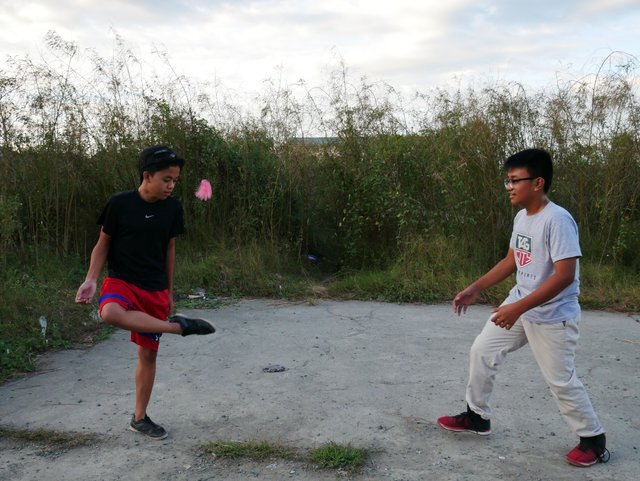
Number of Players: Two or more
What You Need for This Game: Sipa, which is crafted from lead washers typically used on roofs to facilitate the grip of nails in securing the roof. Then, a straw or fabric is utilized to wrap around the washer.
Sipa, derived from the Spanish word for “kick,” is a beloved Filipino game with roots tracing back to the colonial era. In the days before video games, children embraced the outdoors, engaging in this game on the sunlit streets.
The simplicity of Sipa, played with a small, straw-covered washer, requires skill and precision. It reflects an era when kids found joy and skill development in physical play, making it a cherished part of Filipino childhood.
How to Play This Game:
The game involves using the player’s foot to kick a small, flat object, usually a washer covered with straw or cloth, and keeping it in the air using any part of the body except the hands.
The objective is to demonstrate agility and precision in preventing the object from touching the ground. Players can also engage in friendly competitions, showcasing their footwork and coordination, making it a lively social activity in communities.
Pro tip:
- Gauge the wind’s direction. It can be your secret weapon or a tricky opponent, so be mindful.
9. Dampa
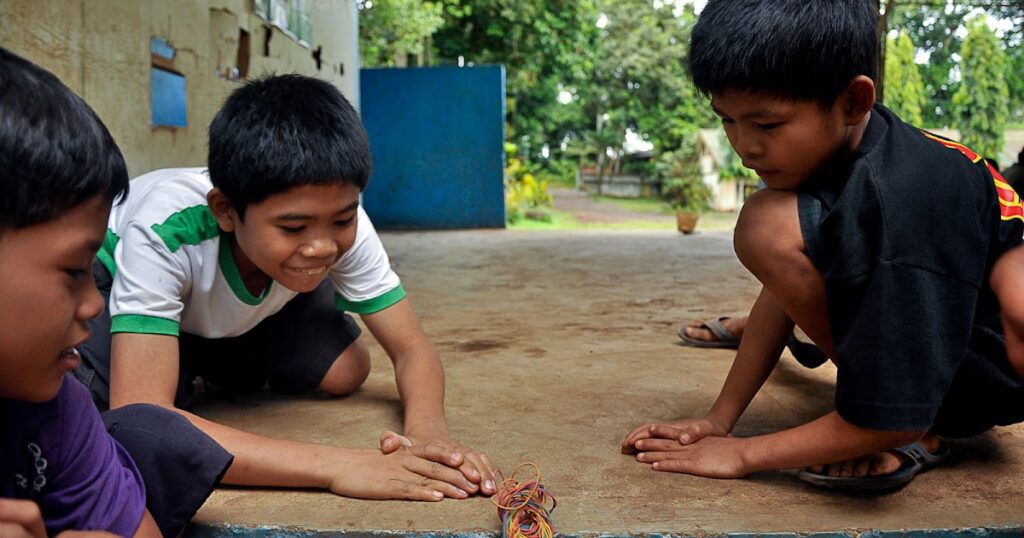
Number of Players: At least two
What You Need for This Game: Rubber bands or also known as “lastiko”
“Dampa” is a nostalgic Filipino game that transforms everyday rubber bands into a source of endless entertainment. Played by striking an air pocket formed using one’s palm against the ground, the game requires both skill and strategy.
Beyond its simple mechanics, Dampa encapsulates the camaraderie and imaginative play that defines traditional Filipino childhood, making it a cherished part of the country’s cultural gaming heritage.
How to Play This Game:
Dampa is played on a flat surface where wrist safety is paramount. With a minimum of two players, each contributing rubber bands to a central pool, the game starts with determining the first player, be it through coin flips, “Jack and Poy,” or volunteering.
The objective is to unravel a stacked rubber band and reach a predetermined finish line. Successfully ending with an odd number secures the rubber bands as a reward, allowing the player to continue.
Conversely, an even count concludes the turn, redistributing the rubber bands among players. While regional variations exist, the basic mechanics are still the same.
Pro tip:
- Experiment with the angle at which you approach the stack. Sometimes a slight tilt can make all the difference in unraveling those bands smoothly.
10. Dama
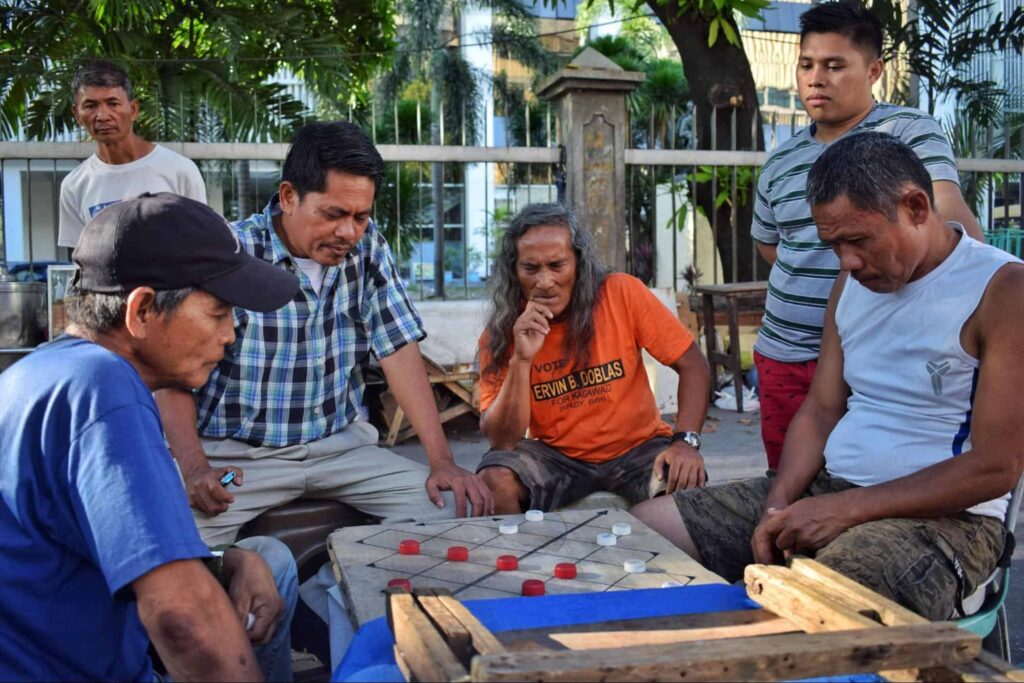
Number of Players: Two
What You Need for This Game:
- Game Board: A board with an 8×8 grid, similar to a checkered chessboard.
- Pieces: Each player has twelve pieces, usually distinguished by color, like dark and light. These pieces are often flat and round.
Known for its simplicity and engaging gameplay, “Dama” has been a staple in Filipino households and street corners, fostering friendly competition and honing strategic thinking among players of all ages.
Typically enjoyed by males aged 10 and older, this game is commonly played indoors.
How to Play This Game:
The objective of this game is to capture all of the opponent’s pieces or block them in a way that they cannot make a legal move.
The game involves diagonal moves and captures, with a special focus on the unique abilities of the pieces, making it a dynamic and engaging test of skill and foresight.
Pro tip:
- Once you have a king, use it strategically. Kings can move diagonally both forward and backward, giving you more flexibility.
11. Palosebo
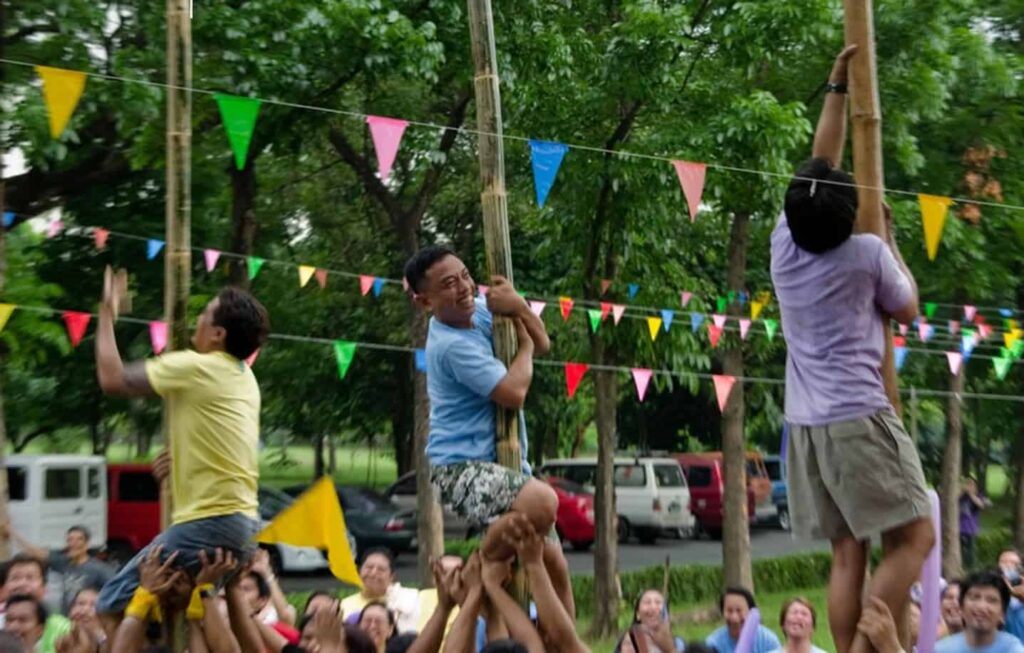
What You Need for This Game:
- Polished and greased bamboo poles that are long and straight.
- A small bag containing prizes which will be attached to the top of the bamboo poles.
- In some instances, a small flag is used as a substitute for the actual prize, which is awarded to the winner afterward.
“PaloSebo” is a hallmark of festive celebrations during town fiestas and special occasions across the provinces in the Philippines. The name is derived from the Spanish words “Palo” (stick or pole) and “Sebo” (grease).
This game is a lively challenge where boys engage in a friendly competition. The game not only showcases physical prowess but also fosters a sense of camaraderie and excitement during community gatherings.
How to Play This Game:
Contestants take turns attempting to climb a tall greased pole to claim the prize at the top. The challenge lies in the slippery surface, making it difficult for participants to ascend.
Those who fail to reach the summit are disqualified, and victory goes to the individual who successfully navigates the greased pole, either untying the prize or retrieving the flag at the pinnacle.
Pro tip:
- Assess the pole’s grease situation before making your move. Sometimes a strategic spot with less grease can be your golden ticket to the top.
12. Hampas Palayok
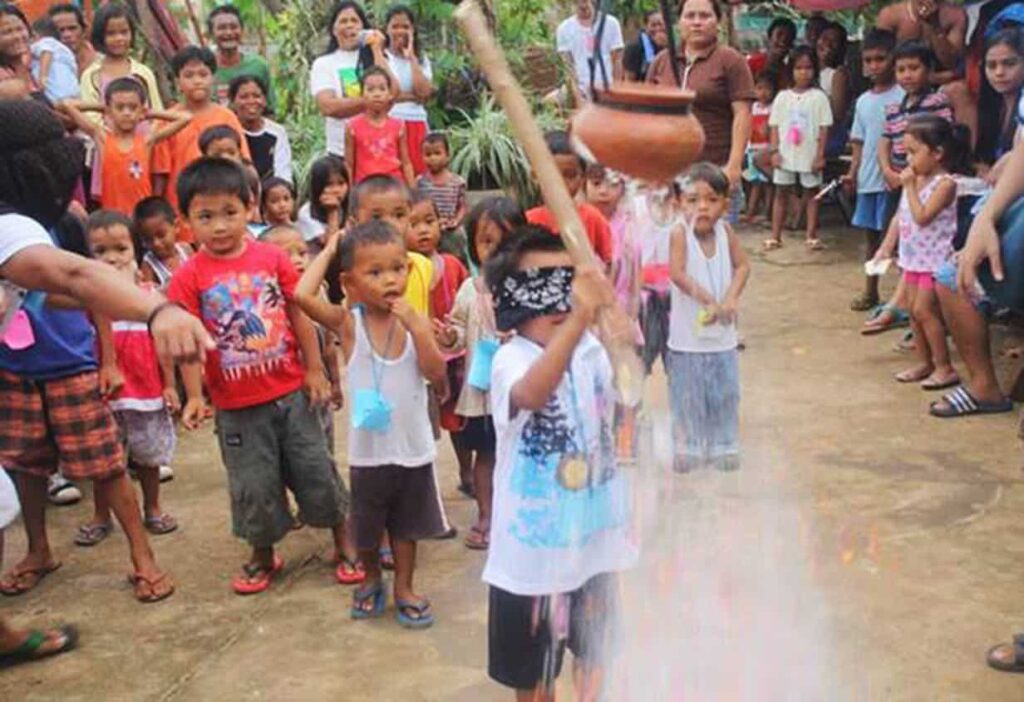
What You Need for This Game:
- Clay pot, or “palayok,” filled with hidden prizes.
- Bamboo stick designated for breaking the clay pot.
“Hampas Palayok,” or hit the pot, holds a special place in Filipino culture, often evoking fond memories of lively celebrations. It was a staple during Barrio Fiesta, providing endless joy to children who are eager to take a swing at the suspended clay pot.
Over the years, this tradition has evolved, and now adults join in the fun during birthday parties, or any special occasion. The game’s popularity lies in its ability to bring people together, fostering a sense of camaraderie and laughter across generations.
How to Play This Game:
Participants form a circle around a suspended clay pot filled with prizes. Blindfolded, one player is tasked with hitting the pot using a bamboo stick while others sing and clap in rhythm.
The blindfolded player must rely on the sounds and cheers to gauge the pot’s location, adding an element of suspense and laughter to the game. The game continues until the pot breaks, and the goodies inside become the reward for the successful striker.
Pro tip:
- If blindfolded, trust your instincts and remember the pot’s height. Feel the swing rather than overthinking the aim.
13. Agawan Base
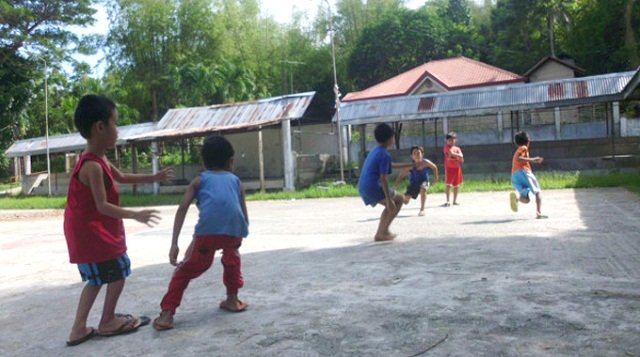
Number of Players: At least four
What You Need for This Game: Items such as slippers or chairs which will serve as bases for each team.
Agawan Base, literally translates to “capturing base,” is a classic Filipino running game often enjoyed during recess or after classes. Played in open grassy fields, it provides the perfect setting for carefree running and chasing.
Beyond its entertainment value, Agawan Base fosters unity, teamwork, and the forging of friendships within the group. Not only is it a delightful pastime, but it also promotes health and physical activity.
How to Play This Game:
Each team guards their designated “base,” and the mission is to stealthily touch the opponent’s base without falling into their clutches. Once caught, you become a prisoner. Your agile teammates must then brave enemy territory to tag you and set you free.
The game’s intensity heightens as teams negotiate and agree on the number of successful tags required for the ultimate victory, making Agawan Base a test of agility, teamwork, and cunning strategy.
Pro tip:
- Develop a cunning strategy for your team – target the weakest links or slow runners among your opponents. Speed is your ally, so run like the wind.
14. Luksong Baka

Place of Origin: Bulacan
Number of Players: 3-10 players
Luksong Baka, is a common sight in the vibrant landscapes of the Philippine countryside. It unites families and friends in laughter and playful competition.
The objective is simple: navigate jumps over the designated “cow” without a touch or stumble. This game not only guarantees fun and friendly rivalry but also promotes physical activity, fostering agility and enhancing motor skills among players.
How to Play This Game:
One player takes on the role of the “bakang lala” or cow, while the others aim to gracefully leap over without making contact. The cow starts in a kneeling position, and players must execute nimble jumps to clear the cow without a hitch.
As the players successfully leap, the cow gradually rises, adding an extra layer of challenge. If a jumper touches or stumbles over, they trade places with the cow, keeping the game dynamic until players collectively decide to end the activity.
Pro tip:
- Ensure a powerful takeoff, maintain firm arms as you lean, and aim for heights with every jump.
15. Sangkayaw
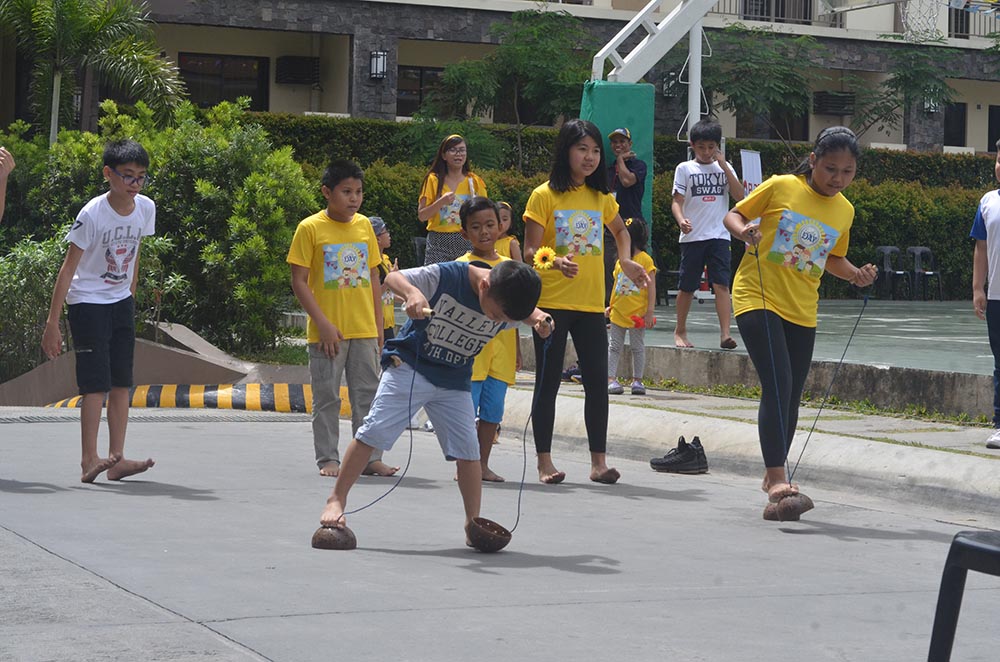
Number of Players: Generally, it requires two teams, each consisting of 10 to 12 members.
What You Need for This Game: The game involves attaching coconut shells to strings, with one end held by the player’s hands.
Sangkayaw, the Filipino coconut shell race, brings a vibrant twist to traditional group games, especially popular in Central Luzon and Tagalog provinces. This game celebrates Filipino resourcefulness, turning everyday items into thrilling competition.
Much like tiyakad, which employs bamboo stilts, Sangkayaw embodies the essence of Filipino camaraderie and outdoor enjoyment.
How to Play This Game:
Teams take turns navigating towards the goal line using coconut shells in a relay-style race. The challenge lies in maintaining balance on the shells, and if a participant happens to tumble, they must restart the race from the beginning.
The team that successfully completes the relay first emerges victorious in this entertaining and skill-demanding Filipino game. The rhythmic clatter of coconut shells adds a distinctive soundtrack to the lively competition.
Pro tip:
- Keep your weight centered, and don’t be afraid to shift your body slightly to maintain balance.





